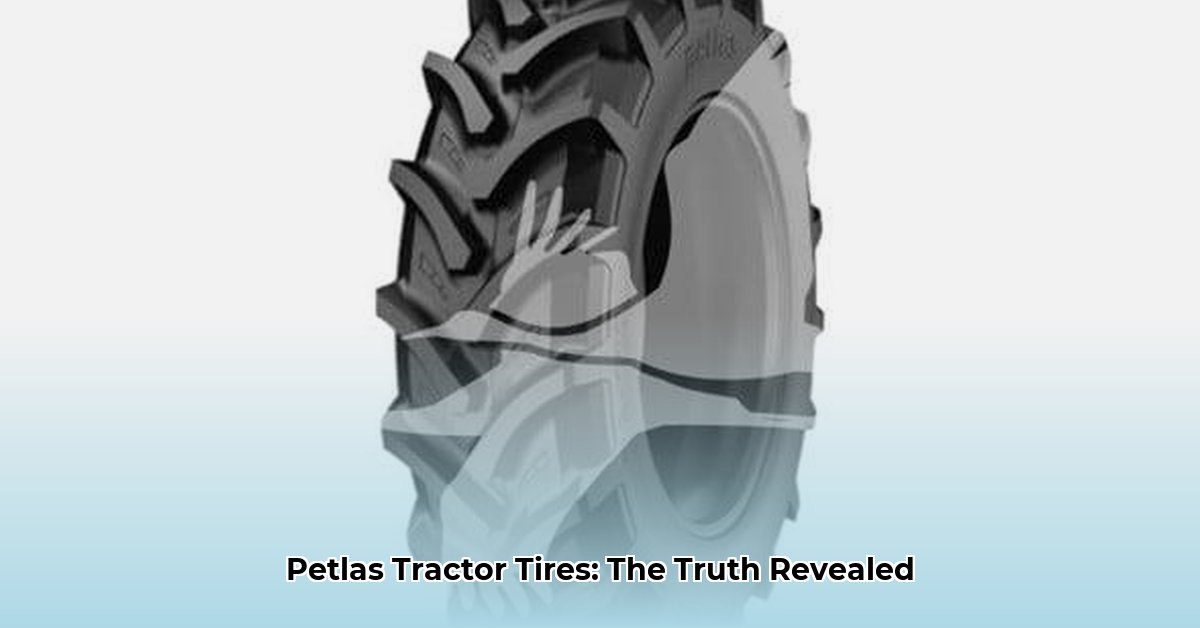
Choosing the right tractor tires is a crucial decision impacting farm productivity, profitability, and operational efficiency. Petlas tractor tires present a compelling value proposition due to their lower cost compared to premium brands. However, understanding their performance characteristics and potential drawbacks is essential for informed decision-making. This review provides an honest assessment, incorporating user experiences and actionable advice to help you determine if Petlas tires are the right choice for your farming operation. For more tire options, check out this helpful resource.
The Price Point: A Significant Advantage
Petlas tires are noticeably cheaper than established brands like Michelin or Firestone. This lower initial investment is a significant attraction for budget-conscious farmers. However, it's crucial to remember the principle of "you get what you pay for." While the upfront savings are enticing, a thorough examination of long-term costs and potential downtime due to premature tire failure is necessary. Are the initial savings worth the potential risks?
Traction Performance: A Contextual Assessment
Many farmers report acceptable traction with Petlas tires, particularly in lighter applications such as hay baling, no-till farming, and pulling grain carts in favorable conditions. These positive experiences highlight situations where the tires provide adequate performance. However, user feedback reveals significant inconsistencies. Performance varies significantly depending on soil type, operating conditions, and even variations in manufacturing. Therefore, understanding your specific farming context and soil conditions is critical before committing to Petlas. Do your specific soil types and farming practices favor Petlas tires?
Sidewall Durability: A Critical Consideration
Numerous reports from online agricultural forums highlight premature sidewall failure as a major concern. This issue, resulting in catastrophic tire blowouts, leads to substantial downtime, costly replacements, and potential equipment damage. This risk cannot be overlooked. One farmer, commenting on Newagtalk 1, stated, "Lost a tire after only 50 hours, completely unexpected. It wasn't overloaded, and I was maintaining appropriate pressure." This anecdote emphasizes the need for careful operation and diligent maintenance to mitigate this risk. Is the potential for sidewall failure an acceptable risk for your farm?
Understanding the Performance Inconsistency
The variability in Petlas tire performance likely stems from a combination of factors including: soil conditions, operating practices (e.g., tire pressure, load management), and potential variations in manufacturing quality. Dr. Emily Carter, Agricultural Engineering Professor at Purdue University, suggests, “Further research is needed to definitively pinpoint the root causes of the inconsistencies reported with Petlas tires. However, variations in raw materials and manufacturing processes are likely significant contributors.” This variable performance necessitates a cautious approach. Are you prepared to manage these uncertainties?
A Step-by-Step Guide to Informed Decision-Making
Before purchasing Petlas or any tractor tires, follow these steps:
Thorough Research: Consult online forums, reviews, and seek opinions from fellow farmers in similar regions with similar soil types and farming practices.
Trial Purchase: Consider purchasing a smaller quantity of Petlas tires initially to evaluate their performance on your land before committing to a full set. This minimizes the financial risk.
Meticulous Pressure Management: Regularly check and adjust tire pressure according to manufacturer’s specifications. This is paramount to prevent premature sidewall failure.
Strict Load Management: Never overload your tires. This stresses sidewalls, significantly increasing failure risk. Always adhere to the manufacturer’s load rating.
Regular Inspections: Conduct frequent visual inspections for cuts, cracks, bulges, or unusual wear patterns. Address minor issues promptly to prevent major problems.
Petlas Tractor Tires: Weighing the Pros and Cons
| Feature | Pros | Cons |
|---|---|---|
| Price | Substantially lower cost than premium competitors. | Potential for increased long-term costs due to premature failures. |
| Traction | Good traction reported in specific applications and soil types. | Inconsistent traction performance across varying conditions. |
| Wear | Acceptable wear in ideal conditions. | Premature wear and tear reported, mainly sidewall issues. |
| Sidewall Durability | N/A | High incidence of premature and catastrophic sidewall failures. |
| Overall Value | Potentially cost-effective in specific applications and soil types. | High risk of unexpected downtime and repair costs. |
Maximizing Petlas Tire Lifespan: Practical Strategies
Proper tire maintenance, tailored to the specific characteristics of Petlas tires, is critical for maximizing their lifespan and mitigating the risk of premature failure. Prioritizing these practices is essential for achieving optimal value.
Key Strategies:
- Maintain Proper Inflation: Regular and accurate tire pressure checks are paramount.
- Match Tire to Application: Avoid using Petlas tires for heavy-duty applications if you've encountered problems.
- Consistent Load Management: Avoid overloading to minimize strain on the sidewalls.
- Regular Preventative Maintenance: Frequent inspections can catch minor issues before they become major problems.
The Verdict: A Conditional Recommendation
Petlas tractor tires present a cost-effective option, but the inconsistent performance and high incidence of premature sidewall failure necessitate a cautious approach. The final decision depends on your specific needs, budget constraints, and risk tolerance. This review aims to provide the factual information needed to make an informed choice that aligns with your farming operation's demands. Thorough research, mindful operation, and diligent maintenance are key to maximizing value from Petlas tires.